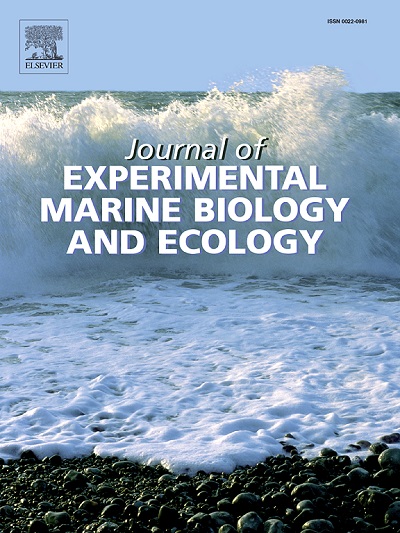Microphytobenthic responses to endobenthic bioturbator density, temperature and eutrophication in a global change mesocosm experiment
IF 1.8
3区 生物学
Q3 ECOLOGY
Journal of Experimental Marine Biology and Ecology
Pub Date : 2024-11-05
DOI:10.1016/j.jembe.2024.152066
引用次数: 0
Abstract
The microphytobenthos (MPB) is a key determinant of ecological processes occurring in coastal sediments, where it functions as a trophic resource, sediment stabiliser and mediator of nutrient cycling and bentho-pelagic coupling. Endobenthic bioturbators are also important components of coastal sediments, wherein they influence ecosystem functioning principally through high sediment and pore-water manipulation rates. However, understanding of how endobenthic engineer activities influence MPB components, especially in the context of global change processes, is limited. We made use of a factorial mesocosm experiment and an in situ optical tool (BenthoTorch) to quantify responses of cyanobacteria, green-algae, diatoms and total MPB biomass to (1) eutrophic vs mesotrophic and (2) high vs low temperature conditions at increasing densities of sandprawns (Kraussillichirus kraussi). These crustaceans are highly influential endobenthic engineers in southern Africa, being widely distributed in estuaries, lagoons and embayments. Findings from our experiment indicated that total MPB biomass and that of cyanobacteria and diatoms (the dominant constituents of MPB assemblages in mesocosms) decreased from controls to maximum sandprawn-density treatments, but predominantly under low temperature. Sediment boundary roughness increased with sandprawn density, suggesting that sandprawn effects on MPB biomass and that of cyanobacteria and diatoms under low temperature was likely sediment mediated, with deposition of residual burrow sediment to the sediment-water interface reducing microalgal productivity. All MPB metrics declined with high temperature, suggesting a physiological intolerance of the MPB assemblages to upper thermal conditions in our experiment or nutrient limitation due to temperature-induced increases in metabolism. Our findings highlight the potential for rising temperature to reduce MPB biomass, as has been reported for open ocean and lake phytoplankton assemblages. Our results also highlight the functional significance of sandprawns in structuring MPB assemblages in coastal ecosystems, but their sediment-mediated limitation of benthic cyanobacterial biomass may confer a degree of resilience to coastal benthic ecosystems against harmful cyanobacterial blooms.
全球变化中型宇宙实验中底栖生物对内生生物扰动密度、温度和富营养化的反应
微底栖生物(MPB)是沿岸沉积物生态过程的关键决定因素,在沿岸沉积物中发挥着营养 资源、沉积物稳定器以及营养循环和底栖与深海耦合中介的作用。内底栖生物扰动器也是沿岸沉积物的重要组成部分,它们主要通过对沉积物和孔隙水的高操纵率来影响生态系统的功能。然而,对于底栖生物工程师的活动如何影响 MPB 成分,特别是在全球变化过程中如何影响 MPB 成分,人们的了解还很有限。我们利用因子中型宇宙实验和原位光学工具(BenthoTorch)量化了蓝藻、绿藻、硅藻和MPB总生物量在以下条件下的反应:(1) 富营养化与中营养化;(2) 高温与低温条件下沙虾(Kraussillichirus kraussi)密度的增加。这些甲壳类是南部非洲极具影响力的底栖工程动物,广泛分布于河口、泻湖和堤坝。我们的实验结果表明,从对照组到最大沙拉密度处理组,MPB 的总生物量以及蓝藻和硅藻(介观模式中 MPB 组合的主要成分)的生物量均有所下降,但主要是在低温条件下。沉积物边界粗糙度随沙盘推演密度的增加而增加,这表明沙盘推演对 MPB 生物量的影响以及低温条件下蓝藻和硅藻生物量的影响很可能是由沉积物介导的,残留的洞穴沉积物沉积到沉积物-水界面降低了微藻类的生产力。所有 MPB 指标都随着高温而下降,这表明在我们的实验中,MPB 群体在生理上不耐受高温条件,或者由于温度引起的新陈代谢增加而导致营养限制。我们的研究结果突显了温度升高可能会减少 MPB 生物量,这一点在开阔海洋和湖泊浮游植物群中已有报道。我们的研究结果还强调了沙虾在构建沿岸生态系统中 MPB 群落中的重要功能,但它们通过沉积物介导的对底栖蓝藻生物量的限制可能会在一定程度上赋予沿岸底栖生态系统抵御有害蓝藻藻华的能力。
本文章由计算机程序翻译,如有差异,请以英文原文为准。
求助全文
约1分钟内获得全文
求助全文
来源期刊
CiteScore
4.30
自引率
0.00%
发文量
98
审稿时长
14 weeks
期刊介绍:
The Journal of Experimental Marine Biology and Ecology provides a forum for experimental ecological research on marine organisms in relation to their environment. Topic areas include studies that focus on biochemistry, physiology, behavior, genetics, and ecological theory. The main emphasis of the Journal lies in hypothesis driven experimental work, both from the laboratory and the field. Natural experiments or descriptive studies that elucidate fundamental ecological processes are welcome. Submissions should have a broad ecological framework beyond the specific study organism or geographic region.
Short communications that highlight emerging issues and exciting discoveries within five printed pages will receive a rapid turnaround. Papers describing important new analytical, computational, experimental and theoretical techniques and methods are encouraged and will be highlighted as Methodological Advances. We welcome proposals for Review Papers synthesizing a specific field within marine ecology. Finally, the journal aims to publish Special Issues at regular intervals synthesizing a particular field of marine science. All printed papers undergo a peer review process before being accepted and will receive a first decision within three months.

 求助内容:
求助内容: 应助结果提醒方式:
应助结果提醒方式:


